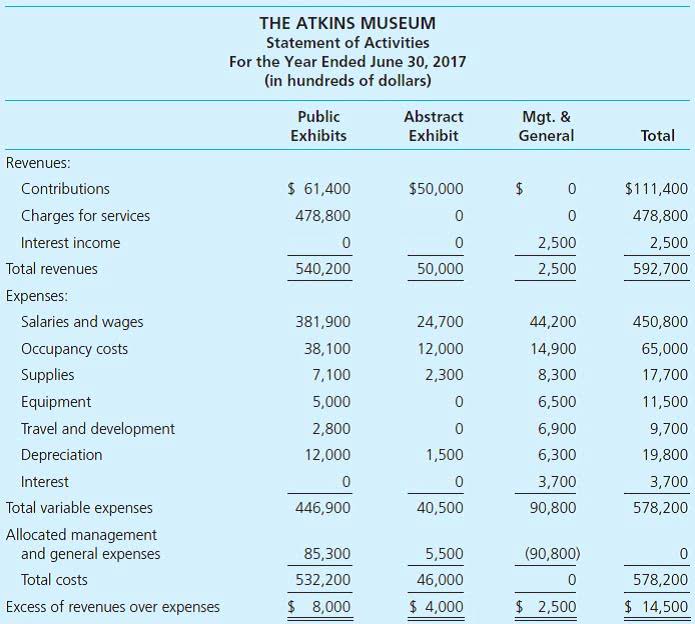
The sum of these three classifications of net assets gives the total net assets for the non-profit. The differences may seem like petty semantics, but Bookstime each is based in a logical purpose. The non-profit doesn’t have owners, for example, making shareholder equity an inapplicable label.

Related Posts
These entries are not merely administrative tasks; they play a significant role in the financial statements of the organization. By accurately recording the release of net assets, nonprofits can provide a clear picture of their financial health and resource allocation. This transparency is essential for maintaining donor trust and fulfilling regulatory requirements. Another key difference is the limitations non-profits have in deploying their assets compared to a accounting for-profit company.

Statement of Revenues, Expenditures, and Changes in Fund Balances
For instance, a donor might provide funds to support a youth education program for a period of three years. During this time, the nonprofit must track and report on the use of these funds to ensure compliance with the donor’s stipulations. Properly managing temporarily restricted net assets is essential for maintaining donor trust and ensuring that the funds are used as intended. Navigating the accounting standards for restricted net assets is a fundamental aspect of nonprofit financial management. These standards ensure that organizations accurately report their financial position and adhere to donor restrictions.
- These funds are designed to provide a perpetual source of income for the nonprofit, with the principal amount remaining intact while the investment income is used for specific purposes.
- The assets are “unrestricted” because they can be used for general expenditures or any other operational purpose(s), i.e., the donor didn’t specify where or how their donation(s) are to be used.
- Through these funds, the organizations can pay off their current expenses as well as look around for other programs or projects that might exist.
- At year-end, whatever net income (Change in Net Assets) you have for the year gets closed to Unrestricted Net Assets.
- The donor contributes the funds and allows the agency to make all decisions regarding the money’s use.
Understanding Percentage Leases: Financial Impact and Key Aspects
Permanently restricted net assets are those that donors have stipulated must be maintained in perpetuity. Typically, these funds are invested, and only the income generated from these investments can be used, often for specific purposes outlined by the donor. This category of net assets is less flexible but provides a stable financial foundation for the organization. Nonprofit organizations in the U.S. produce a Statement of Financial Position which is equivalent to the balance sheet maintained by a business. Unrestricted net assets, temporarily restricted net assets, and permanently restricted net assets all are listed on this statement. Next you will need to add some columns and rows and do some calculating to determine the debits and credits that get you to the desired new balances for your “internal” net asset accounts.

Hi Jovy, follow up question will this account automatically close to Retained earnings? That net income is already seen in Equity for the current FY, so nothing really changed.
Unrestricted net assets are donations to nonprofit organizations that have no strings attached. That is, the assets may be used by the organization for general expenses or any legitimate expenditure. In order to split net income and retained earnings into the net asset accounts appropriate for our purposes, we need a little work-around. To prepare this entry, you will need to determine what the new ending balances need to be. unrestricted net assets Fund accounting relies on knowing the purpose of the money received and reporting the organization’s finances based on the purpose.
Endowment Funds and Permanently Restricted Net Assets
What if the $100,000 grant was restricted not for a building, but for use in running a counseling service? You’d have to check the details of the grant to see exactly what types of expenses are included. Likely there’s a budget that shows how much can be spent on payroll, technology, office expenses, etc. In that case, you would be in luck if you wanted to use the money for the counseling program. I don’t understand why we can’t pay the bills,” exclaimed Todd, a member of the board of directors, as he looked at the balance sheet. Don’t hesitate to reply anytime if you still have questions or concerns about retained earnings account.

Fund accounting is one of the popular accounting methods used by not-for-profit organizations for recording and reporting financial transactions. Now that you know the concept, look at your organization’s balance sheet again with fresh eyes. Keep in mind that, unfortunately, net assets is often not broken out properly in internally generated balance sheets.
- By accurately reporting these changes, nonprofits can offer a transparent account of how donor contributions are being utilized, thereby reinforcing donor confidence and fostering long-term support.
- Since the file is relatively new, I simply edited the first entries in the checking and savings accounts, and changed “Opening Balance Equity” to “Unrestricted Net Assets”.
- Fund accounting is one of the popular accounting methods used by not-for-profit organizations for recording and reporting financial transactions.
- When I set up a new QuickBooks file for an (existing) non profit, I entered the opening balance for the checking account, which went into “Opening Balance Equity”.
First, some important differences between for profit and non-profit accounting
The objective is to present clear and easily readable reports, and not to make the reader work hard to figure it out. Accounting for and reporting net assets in these more detailed categories for internal reports is valuable and recommended and gives a clearer picture of the organization’s actual financial position for the board and other stakeholders. Permanently restricted assets often come in the form of a fund that must be maintained indefinitely, with the income generated by its investment to be used for a particular purpose. Organizations typically prefer donations of unrestricted net assets because they allow them maximum flexibility to spend as they see fit, whether for hiring additional personnel or expanding their services. The debit to the Restricted account reduces the account balance by the amount that was released from restriction.
دیدگاه شما